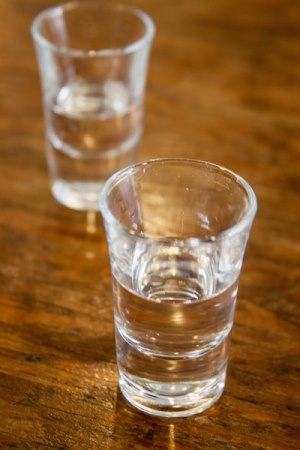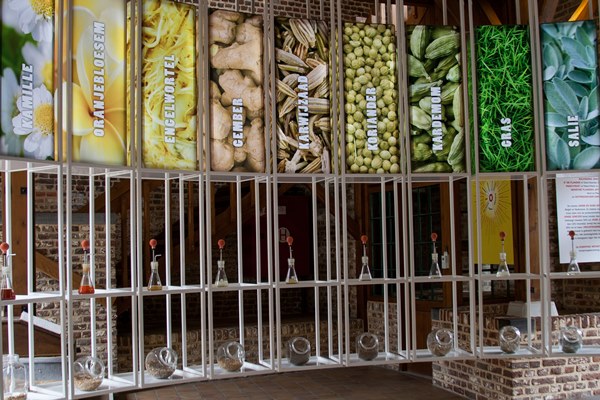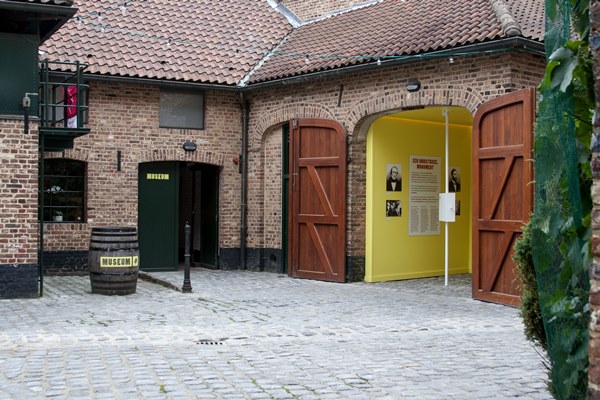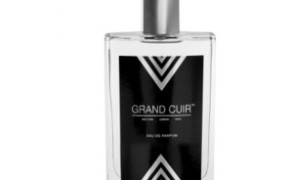Museums where you can exercise your sense of smell are few and far between. As anyone who has tried to convince a gallery to add a fragrance exposition knows, it can be a difficult undertaking. “Not enough funding” is a common excuse. One is left treating the aisles of Sephora as the august halls of perfume education. Or so it seems at first, because besides museums featuring fragrance, there are numerous venues that feature scent. For instance, any museum dedicated to wine or spirits would have a smelling bar and an explanation of aromatics. That you can later taste the stars of the exhibit only adds to the appeal.


During my research on the lavender farm in Limburg, I discovered that Hasselt, the province’s capital, has a jenever museum. Jenever, also known as genièvre, genever or peket, is an ancestor of gin, a local spirit made out of grain and flavored with juniper and other botanicals, and it has been made in the region since the 13th century. Wine and brandy distilled from grapes have traditionally been expensive, while the surfeit of corn brought from the New World made aqua vitae distillers eager to experiment. The result was a drink described as “banishing cares and making the heart courageous.”
That this 75 proof liquor has such an effect is easy enough to believe. Jenever might have started out as medicine, but instead of using sugar to mask the rough taste of the alcohol base, pharmacists chose a much more interesting approach by flavoring it with spices, herbs and flowers. Eventually, locally grown juniper started to dominate the composition, while jenever moved from the pharmacy shelf to the cafe.
The Hasselt museum covers the most minute aspects of production, explaining how jenever starts with a blend of malted grain (Hasselt distilleries use corn). Ground grains are mixed with water, and the mash is fermented before undergoing a several step process of distillation, filtration and blending. Some jenevers are then aged.
The changing political landscape has affected various aspects of life in the Low Countries dramatically, and this touched jenever too. For instance, the Eighty Years War (1568-1648) that led to the separation of the Northern and Southern Netherlands caused Flemish jenever and brandy producers to set off for other parts of the world and even set up distilleries in England and America. The changing attitudes towards drinking in the 19th century branded jenever, once considered the ultimate healthy potion, as the root of all social ills. The propaganda posters alone are worth the price of admission.

A fun part of the museum is the smelling room. Different methods of fermentation produce their distinctive aromatics, and the base alcohol is then flavored with a blend of spices and herbs. Juniper is a star flavor component, but it may be accented with orange blossom, cardamom or bittersweet gentian root. Another jenever maker might select a velvety combination of angelica and violet and make it fiery with pepper and cinnamon. The museum display includes the most commonly used ingredients with tinctures in small diffusers. By the time we reached the museum shop, which appropriately enough includes a bar, I already felt slightly lightheaded.
Jenever remains one of the favorite drinks in Belgium and the Netherlands, and while the area around Hasselt is no longer studded with distilleries, jenever is still produced, both by large brands and artisanal houses, and enjoys the EU protection of origin. Coca Cola has nothing on the secrecy with which jenever makers protect their formulas, but you can use your nose to unravel some of the mysteries. After all, colognes originally started as concoctions to be taken internally.
Although both jenever and gin include juniper, jenever doesn’t taste piney. Since it’s made with some malted grain, the flavor can resemble a light Scotch whisky with a botanical bouquet, the complexity of which depends on the individual maker. Jenevers can be labeled as oude, jonge and korenwijn, referring to their distillation method, rather than the length of aging. For instance, oude jenever must include between 15% and 50% of malt wine (a grain mash) and is often barrel-aged, while jonge never features more than 15% of malt wine. This makes oude jenever taste closer to Scotch, while jonge is more neutral like vodka. Korenwijn includes 15% to 70% of malt wine, so its flavor is dominated by malty notes.

Before the prohibition in the 30s, the United States used to import a prodigious quantity of jenever, but today it’s no longer the case. To try some of the most interesting varieties, you have to visit Belgium, best of all during the annual Jeneverfeesten which takes place in Hasselt in October. (Jenever is also made in some parts of Germany and France.) On the other hand hand, Dutch brands like Bols and Boomsma are exported and sold widely in North America. Boomsma’s oude jenever aged in oak barrels has a rich but pure flavor, while Bols’s 18 month aged version is malty, with a spicy accent. You might also be able to find Stokerij De Moor and Biercée Distillery jenevers, both Belgian, in the States. Enjoy jenever in a small, tulip shaped glass filled to the brim. It’s guaranteed to banish all cares, if only temporarily.
Photography by Bois de Jasmin
















81 Comments
Ruth: I don’t like gin but I like juniper, odd but true. I’d be interested to try jenever for comparison. September 11, 2015 at 8:24am
Marieke: I also don’t like gin and I like jenever. It’s not as sharp. September 11, 2015 at 11:21am
Victoria: Agreed. It’s definitely much softer, although it also depends on the variety. Mostly, it doesn’t have the piney, woodsy taste like gin does. September 11, 2015 at 12:23pm
Victoria: I like both gin and jenever, but jenever is really more like Scotch than gin (jonge is more like vodka but an extra layer of flavor). So if you like malty tastes in your liquor, give jenever a try. September 11, 2015 at 12:09pm
Alan Jackson: I like juniper but Gin is my favorite. Its surprising for me to know how can a person don’t like Gin. September 13, 2015 at 6:36pm
Victoria: People often find the piney taste of juniper an acquired taste. I discovered it when cooking with juniper berries. Some of my friends loved the flavor, but others found it odd. September 14, 2015 at 11:56am
Allison C.: Fascinating article! I didn’t really know much about jenever. One of my local watering holes offers a cocktail made with Bols Genever, St. Germain, Aperol, and lemon – it’s quite lovely! September 11, 2015 at 9:12am
Victoria: That sounds wonderful! St. Germain elderflower liqueur on its own is a lovely thing (and the description reads like a perfume). Elderflower is used a lot around here, and I recently tried Belgian gin & tonic with a distinct elderflower taste. It turned out they used the extract to flavor the tonic water. September 11, 2015 at 12:14pm
Marc: Very interesting, thanks a lot! Jenever Fest must be a lot of fun. September 11, 2015 at 9:26am
Victoria: I haven’t visited yet during that time of year, but I imagine it would be fun. And lots of jenever available in all forms. 🙂 September 11, 2015 at 12:15pm
Rebecca: Very interesting. Is there a resurgence in general of botanical flavored beverages? An Italian friend of mine who lives in the states noticed on a recent trip home that a large variety of “amaro” liqueur is commonly available in bars. While these seem to have existed for a long time, he doesn’t remember them being popular.
Cynar is the one I remember, given to me by my mother-in-law as a cure for an upset stomach (both effective and unpleasant) but apparently there are many others… September 11, 2015 at 9:33am
limegreen: I was introduced to “amaro del capo” (recently in Naples) as a “digestive” — great medicine! I was trying to pick out the flavors and herbs — there was juniper in it, I think. September 11, 2015 at 11:20am
Victoria: Amaro Averna is something I also like. The makers don’t divulge the components, but I notice bitter orange, licorice and angelica in it. Now, I’m having a craving for some. 🙂 September 11, 2015 at 12:23pm
limegreen: That sounds delicious! (And would be an interesting perfume to smell.)
There’s also a yummy Italian digestive with myrtle in it.
I asked about what was in the amaro del capo and was told it was a secret. 🙂
If it weren’t for the carryon restrictions I would have brought home a huge bottle of amaro del capo (only 7 euros!). September 11, 2015 at 12:28pm
Victoria: You’re sending me down a memory lane with your mention of a myrtle digestive. Years ago a friend of mine studied in Italy, and I used to visit her often and stay with the family that hosted her. The father was an avid cook, and he made his own wine and various liqueurs, including the myrtle liqueur. It was nothing like I’ve tasted before.
In fact, I bought a package of myrtle berries from a Corsican stand at the market the other day, just in his memory. I have no idea what I’m going to do with them, but they smell amazing. September 11, 2015 at 12:41pm
limegreen: The homemade ones are so fragrant, you’re so lucky to have tasted those!
My Italian friend here introduced me to Mirto, the myrtle digestive I mentioned, from Sardenia, I think. She was so excited to find it here, and it was such a taste sesnsation for me. I’m not that familiar with myrtle so it is my only myrtle contact.
Will you make a digestive with your myrtle berries? September 11, 2015 at 1:41pm
Victoria: It was also the first time for me, and I love the taste and scent. Myrtle is also used in perfumery, and it’s an aromatic, green, spicy note.
I don’t have enough berries for a digestive. I was thinking of adding them to stews the way one adds juniper. Pork with myrtle berries, carrots, onions and white wine was one of my ideas. September 11, 2015 at 4:40pm
Marieke: Cynar is made from artichoke, no? September 11, 2015 at 11:27am
Rebecca: That’s Carciofo, I believe. I have never dared to try it! September 11, 2015 at 12:16pm
Victoria: Maybe Rebecca knows for sure, but I remember reading that it’s made from a number of different herbs and spices, including artichoke. September 11, 2015 at 12:26pm
Annabelle: Yes, Cynar is made with artichoke. Too bitter for me. I choose Campari. September 11, 2015 at 2:37pm
Victoria: I’m also partial to Campari, especially when mixed with white wine. September 11, 2015 at 4:47pm
Annabelle: Hope it’s ok to post a link
http://www.camparigroup.com/en/brands/liqueursothers/cynar
“The artichoke liqueur known for its versatility and taste Cynar is an artichoke based bitter. Its distinctive flavour is enriched from an infusion of 13 herbs and plants, making it a completely natural drink, rich in scents and a unique taste .”/ September 11, 2015 at 2:38pm
Victoria: Yes, of course! Thank you for the extra info, Annabelle. September 11, 2015 at 4:47pm
Victoria: I think you’re right, there is definitely a resurgence, if not of botanically flavored beverages specifically, then of older, more traditional drinks, many of which are flavored with botanicals. Gin is also experiencing a revival in Belgium, and there are gin bars around here offering unusual varieties. Some are quite good.
Jenever was always popular in Belgium, but its reputation used to be like that of sherry in the UK. In other words, not a particularly trendy drink. On the other hand, as people rediscover it and small producers offer new, more nuanced or more unusual varieties, people are starting to pay more attention. September 11, 2015 at 12:19pm
Victoria: P.S. As for Cynar, the first time I tried it in Italy, I thought that one needs to be thoroughly intoxicated to drink something like that, but I ended up liking that bitter taste. Now I find it almost addictive. My husband, on the other hand, can’t stand it. September 11, 2015 at 12:20pm
Marieke: It’s a delight to find a post about jenever here. I’m Dutch and we have it too. My grandfather used to drink it and I remember the smell as he opened the bottle. Once I took a sip from his glass when he wasn’t looking and it was like my whole face was on fire. I was 6 or 7. 🙂
If you want to try artisanal Dutch jenever, I recommend De Borgen. September 11, 2015 at 11:26am
Victoria: Thank you for a recommendation, Marieke! I will have to look for De Borgen. Hasselt museum store had a number of varieties (all Belgian), so we tried a couple and bought a bottle to take home to do more proper research. 🙂 September 11, 2015 at 12:25pm
Tammy: As interesting as the historical connections between liquor and perfume’s nascence may be, I wonder what the differences in their chemical compositions are, since perfume doesn’t age like wine. It doesn’t mature. Distiller oils go rancid with time even if protected against light and air.
But I agree, museums are scopocentric (is that a word? Maybe I just invented one!) and not stereocentric or care about ephemeral things like fumes and osmotics. But then is it necessary to curate and domesticate everything within four walls to give it a certificate of artistic and cultural importance. Maybe it is time to rethink the function and necessity of this strange space called the “museum”. September 11, 2015 at 11:45am
Victoria: Aging is very important of perfumery too, and in the past before stabilizers and preservatives were used as much as they are now, perfume aged the way wine would. Of course, not all liquors age. Many botanically flavored varieties also just degrade. On the other hand, some essential oils age beautifully. Aged patchouli is one of the nicest things to smell.
I don’t care much for certificates of importance, but I’m all for the museums as spaces of learning and enjoyment. I could have gone to any liquor store to pick up a bottle of jenever or a bar, but neither experience would add much to my understanding of this drink in the cultural and historical context the way a visit to the wonderful Hasselt museum did. September 11, 2015 at 12:33pm
Tammy: Learning, entertainment and…business. September 11, 2015 at 4:51pm
Victoria: Sure, but I’m ok with that, as long as a museum accomplishes the first two goals well. September 11, 2015 at 5:02pm
Owen: A museum where you can drink? Only in Europe! 😀 September 11, 2015 at 11:45am
Victoria: 🙂 And their museum store was fab! September 11, 2015 at 12:33pm
Annikky: I keep thinking that I need to try this, I really should get my act together and buy some. Do you have any favourite brands? And which of the three varieties do you like best? September 11, 2015 at 12:03pm
Victoria: I really liked Hasseltse Jenever by Stookkot distillery. It’s called Vieux systeme, so it’s aged. I’m at home right now, so I just pulled out the bottle and I’m taking a whiff. It really smells like an autumnal orchard–pears, walnut shells and a hint of malt.
Overall, I prefer anything aged, because jonge makes me think too much of vodka and they’re less exotic. By the way, many are packaged in bottles that look like Riga balsam. Do you remember those tall, opaque ceramic bottles? September 11, 2015 at 12:38pm
Austenfan: It’s funny finding a post on Jenever on this blog. A great aunt of mine used to work with Bokma a Friesian Jenever distillery. They were bought by Heineken in the late seventies I believe. I well remember the bottles that she used to offer as gifts to my parent and grandparents. But truth to tell I’ve never tried Jenever. I need to remedy that I believe. Fun post! September 11, 2015 at 12:30pm
Victoria: We talked to the gentleman running the museum store (ok, it was really more like a bar 🙂 and he mentioned that many small distillers were taken over by large ones. One of the reasons people switched to something else is because in the takeover process, the quality went down and the prices went up. It reminded me of the stories of artisanal perfume brands being bought by large corporations. But now, both in Belgium and The Netherlands a new generation of distillers is making their mark.
Have you visited Hasselt before? September 11, 2015 at 12:45pm
Austenfan: I love that kind of museum store! I visited the Palais Bénédictine in Fécamp a few years ago. It’s actually a nice place with some interesting art. It ended with a very welcome glass of Bénédictine, simply lovely. September 11, 2015 at 2:48pm
Victoria: Hasselt museum had some interesting old adverts and posters. The anti-drinking posters from the 19th century were really funny.
You’ve covered so much of France in your travels. It’s very impressive. And this also reminds me of that I’ve never tried Bénédictine. September 11, 2015 at 4:51pm
Austenfan: And I still haven’t seen all of it. Well it’s all to do with convenience really. It is such an easy country to travel in with a dog and so accessible from where I live.
All in all I’m much less of a traveller than you are.
On another note, I’m guessing you would like Bénédictine. It is fairly sweet but in an interesting way if you see what I mean. Have you tried Génépi? September 12, 2015 at 2:02pm
Victoria: I haven’t tried Génépi either, although the name is familiar. Many of these liqueurs are based on very old recipes, and since perfumes in their early forms didn’t differ much from liqueurs, you can get more of an idea what fragrances used to be like in the past from blends like the ones we’ve mentioned. By the way, there is one cologne in Guerlain’s collection which is made with drinkable alcohol, but I don’t remember which one it is. September 12, 2015 at 3:59pm
Austenfan: Oh, and I haven’t visited Hasselt. My travels in Belgium have so far been more in the West of the country. September 12, 2015 at 1:58pm
Victoria: I, on the other hand, need to explore more of the West. We covered lots of ground already, but there are still places we need to visit. We still haven’t gotten to Liege. September 12, 2015 at 3:55pm
Raluca: Victoria, unrelated to this post, I would love to read your thoughts on Tom Ford Noir pour Femme. Thank you! 🙂 September 11, 2015 at 12:33pm
Victoria: Have you tried it already? I haven’t yet seen it around here. Very curious to smell it. September 11, 2015 at 12:39pm
Raluca: Yes, I have and even bought a 1 oz bottle. Already got compliments on it. Can’t wait to read your thoughts on this one. Also, Fleur de Chine is going away. September 14, 2015 at 10:55am
Victoria: I heard about that, and this made me so sad. It was my favorite Private Blend. September 14, 2015 at 12:41pm
ChristineB: What an interesting post. I love going to museums like that. Here in the UK I gave as a birthday present to my husband a tour round a local brewery which prides itself on its history and its local beers. It was fascinating and yes, we also got to smell the different types of barley and hops used in the various beers.
Also in the UK there seems to be quite a resurgence in making gin. Last year we bought a locally distilled gin made by a family company consisting of brothers and sisters. It was quite unusual in that it was flavoured (and scented) with vanilla as one of the dominant notes. Much to my surprise it made a very good gin and tonic. it also came in a lovely bottle and we have used the bottle and its vanilla scented dregs to make sloe gin ( using a cheaper gin!) from sloes that we picked from the hedgerows. September 11, 2015 at 2:36pm
Victoria: A visit to a brewery sounds like so much fun. I imagine that different types of barley and hops smell very distinctive. My husband made beer at home once, although I wasn’t around during the brewing process, I smelled remnants of the malted barley he used, and I liked it a lot. Hops were a surprise too. My grandmother’s garden is infested with them, and I’ve spent many hours pulling the vines out, but of course, fresh hops smell differently from dried ones.
Your sloe gin with a vanilla inflection sounds like a true artisanal creation! Did you already taste it? September 11, 2015 at 4:46pm
Wym: Fun post and great blog! Not to be forgotten is the kopstoot, a classical Dutch combination of beer and a shot of jenever. It’s called “headbutt” for a reason. September 11, 2015 at 2:46pm
Victoria: It sounds dangerous. 🙂 Also, it reminds me of a Russian pairing of beer and vodka. I’ve never tried it, since I can’t imagine that either beer and vodka would be improved by being mixed together. September 11, 2015 at 4:50pm
Cornelia Blimber: As far as I know, ”kopstoot” is a glass of jenever and a glass of beer, not mixed together. You first drink the jenever, and after that the beer.
It’s refreshing. I don’t like jenever, I do this with wodka. September 11, 2015 at 5:05pm
Victoria: So you sip one and then another? Or just chase jenever with beer? September 11, 2015 at 5:10pm
Cornelia Blimber: I don’t sip vodka, I finish the glass (a little glass of course) at a draught. And then the beer as a chaser. September 11, 2015 at 5:18pm
Victoria: I think that it must be much better than a simple mix of two drinks. September 11, 2015 at 5:24pm
Mer: I bring bottles of oud Fillliers jenever to my dad, who otherwise puts rum or brandy in his coffee (this is a carajillo), he loves it!
Me, I love Elixir d’Anvers, have you tried it? September 12, 2015 at 2:31am
Victoria: I haven’t. Is it herbal or more spiced?
Jenever and coffee sounds like a perfume-worthy combination. This I’ll definitely try. September 12, 2015 at 2:59am
Mer: It is herbal and fragrant, a fairy drink, you should try it! (very sweet too, like all these types of liqueurs, but not cloying-sweet). September 12, 2015 at 5:46am
Victoria: I prefer herbal liqueurs, and even if they’re sweet, they’re somehow still palatable. Have you tried Strega? September 12, 2015 at 8:34am
Mer: Ohh, saffron? I haven’t tried it. Do you find it in Brussels? I have never seen it Leuven, or elsewhere really. It sounds great. September 12, 2015 at 9:04am
Victoria: I recommend checking Italian stores in Leuven, because that’s where I got mine. I don’t remember which store exactly it was, but it might have been near Elsen kaasambacht. Or that large wine store off Hooverplein might have it. Strega really could be a perfume. September 12, 2015 at 9:09am
Victoria: And before I forget, you can cook with it. It goes well with fish and tomato based dishes. I usually add a spoonful to tomato sauce and then braise fish with green olives in it. September 12, 2015 at 9:10am
Mer: Oh, and had missed this comment. I never had thought of using liqueurs for cooking! I shall experiment.
Did you get a chance to try Elixir D’Anvers? Today I found a bottle of Strega in the shop you mentioned (I had never been to it, I’m so unadventurous), of course I didn’t wait til evening to try it 😉 I find it’s in the same style than Elixir but perhaps less sweet and with a slightly different flavour, very herby I love it! Unfortunately my palate isn’t refined enough to detect the saffron (admittedly I have a cold at the moment, but I still don’t have a refined palate ;)) September 18, 2015 at 6:47am
Victoria: Not yet, but it’s on my shopping list.
Saffron is mild, and there are so many other things going on in Strega. I love that medicinal bitterness. It tastes like something that could be good for you, although it’s also delicious. September 18, 2015 at 1:54pm
Mer: Oh, I know where you mean. I used to live right around the corner but I’ve never investigated. Will do! September 12, 2015 at 9:10am
Victoria: Yeah, that place has the densest concentration of gourmet stores on earth. 🙂 I swear just that street alone made my adjustment to the life in Belgium easier. September 12, 2015 at 9:15am
Mer: Now I want some, I always have a bottle, but it’s definitely too early for that 🙂 September 12, 2015 at 5:47am
Victoria: I was thinking the same thing, but then I decided that there is still some work to be done, so maybe I shouldn’t consider it. In a couple of hours though this shall be done. In the name of research, of course! 🙂 September 12, 2015 at 8:35am
Katy: It is never too early to put a splash of good Bourbon in coffee, so I encourage you to tipple when you have the urge! I will seek this out since I know I would love it! There is such a deep connection between loving gardening, Bonsai, perfume, incredible liqueurs, beers , wine and spices. I wish I could more articulately explain why these things, all important to me, share roots because they are of the earth, sky, water. Nature distilled to it’s loveliest essences. We all hunger for and need this, not just bodily but spiritually too. September 12, 2015 at 10:35am
Victoria: 🙂 You would find many Belgians who agree. I often see people enjoying a glass of wine at a cafe nearby as early as 9am.
The way you see the link among all of your favorite things is such a beautiful and inspiring sentiment. September 12, 2015 at 3:54pm
bregje: I don’t really like the taste of jenever but in/on Terschelling they have a herbal bitter made of jenever and herbs that grow in the dunes that’s very tasty. And it helps when you’ve caught a cold(or so they say 😉 ).
It’s called jutter bitter (beachcomber’s bitter).
Also like aperol.I drink spritz all summer.
My grandfather was a Bols-jenever fan.There was always a bottle in my grandparent’s freezer.
Off topic:
My brother became the father of a baby-girl last sunday and her name is Jasmijn(dutch for jasmin)! Great name or what? September 12, 2015 at 7:35pm
Victoria: Congratulations! What a lovely name. 🙂 May she grow healthy and happy.
Jutter bitter sounds even more interesting. I wouldn’t have learned of it if it weren’t for your recommendation, so it’s now on my list of things to try. Do you think it can be found outside of Terschelling too? September 13, 2015 at 4:16am
bregje: i think you can even get it at internet liquor stores.
Be careful though.There are several touristic versions with cranberries or other fruits.Those are much sweeter than the original. September 13, 2015 at 4:55pm
Victoria: Thank you for warning me. I will look for the original version. September 14, 2015 at 11:56am
Tulsi: My grandfather always drank jenever, my mum would buy it for him when he came over. I was always intrigued by the glass filled to the brim, with a little convex on top.
We now live very close to Schiedam, Jenever city of The Netherlands. There’s a jenever museum too, many old windmills for milling grain.
We went to a dreupelkot (jenever bar) in Gent once, they had many many flavours like lemon, witloof (chicory), cherry. That was fun! September 13, 2015 at 11:34am
Victoria: That really sounds fun! I wonder what chicory jenever tasted like. September 14, 2015 at 11:54am
Sony Joshi: I like jenever not gin as it tastes like vodka and i don’t like vodka too… October 8, 2015 at 8:16am
Lyricab: This is all about fun and I too like jenever. December 7, 2017 at 1:27pm
Manish Dangi: Nice article..loved it February 21, 2020 at 11:02am
Stive: I like Gin. May 31, 2020 at 1:47pm